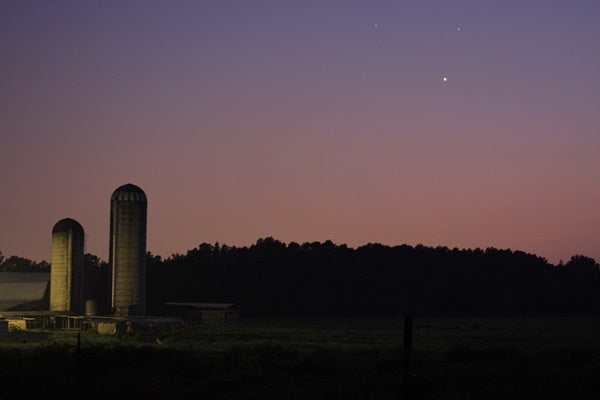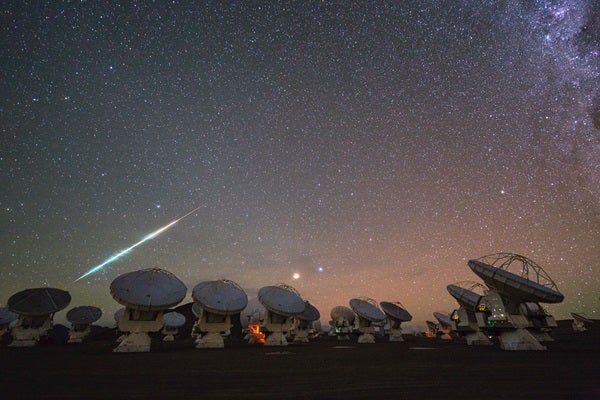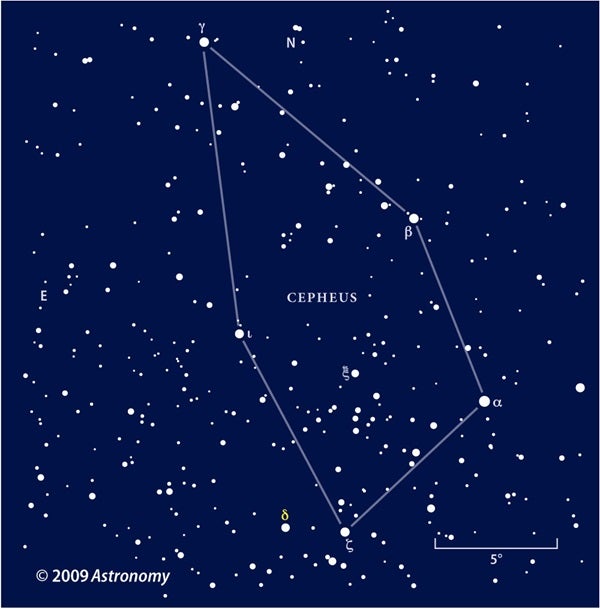Friday, March 11
Step outside after dark to see the familiar W shape of Cassiopeia on its side in the northern sky. Tonight, we’re zooming in on the star Eta (η) Cassiopeiae, located just southeast of the midpoint of the line connecting Navi and Shedar (both magnitude 2.2), which form the right side of the W (or the bottom half, as it’s oriented early this evening).
Magnitude 3.5 Eta sits 1.7° northeast of Shedar. It’s visible to the naked eye, but point of pair of binoculars its way and you’ll see that it’s not one but two stars. This binary system contains a magnitude 3.4 star and a magnitude 7.5 star, separated by 12.9″. And what’s really interesting is their colors: While the brighter primary is clearly yellow-hued, the fainter secondary is much redder (and thus cooler). Once you’ve found them, bump up your magnification to 100x or more to make the color contrast even clearer.
Sunrise: 6:18 A.M.
Sunset: 6:03 P.M.
Moonrise: 11:26 A.M.
Moonset: 2:24 A.M.
Moon Phase: Waxing gibbous (62%)
*Times for sunrise, sunset, moonrise, and moonset are given in local time from 40° N 90° W. The Moon’s illumination is given at 12 P.M. local time from the same location.
Saturday, March 12
Venus passes 4° north of Mars at 9 A.M. EST this morning. You can catch them a few hours earlier, some 10° high in western Capricornus an hour before sunrise. Venus is a brilliant magnitude –4.6 and spans 27″ in a telescope, showing off 45-percent-lit disk. To its lower right is Mars, a much fainter magnitude 1.2 and just 5″ across, unfortunately rendering any planetary features difficult to see.
Shortly after 5 A.M. local time, a third planet has risen. Magnitude 0.7 Saturn now sits in central Capricornus, 15.5° east of Mars and 4° west of 3rd-magnitude Deneb Algedi, which follows the planet up into the twilight before disappearing in the brightening sky. Train a telescope on Saturn in the growing dawn for a glimpse of its stunning ring system, stretching roughly 36″ from end to end. Take care to put down the telescope several minutes before the Sun is set to rise at your location.
Sunrise: 6:16 A.M.
Sunset: 6:04 P.M.
Moonrise: 12:18 P.M.
Moonset: 3:16 A.M.
Moon Phase: Waxing gibbous (71%)
Sunday, March 13
Daylight saving time begins this morning at 2 A.M. For regions that observe the time change, clocks will “spring forward” one hour.
The planet Neptune is in conjunction with the Sun at 8 A.M. EDT. This cosmic geometry renders it invisible all month, but the ice giant will reappear in the morning sky in early April.
If you do happen to be up before the Sun this morning, take advantage of the small dark window between moonset and the onset of twilight to scan the skies for sporadic meteors. Although there is no major meteor shower this month, random chunks of space dust litter the inner solar system and generate a small background rate of about 6 meteors per hour this time of year. Morning is the best time to try to spot shooting stars, as this is when your location is on the leading hemisphere of Earth and meteors will strike the atmosphere head-on.
Sunrise: 7:14 A.M.
Sunset: 7:05 P.M.
Moonrise: 2:17 P.M.
Moonset: 5:01 A.M.
Moon Phase: Waxing gibbous (79%)
Monday, March 14
Starting tonight, Uranus will spend the next several days (though the 23rd) within about 18′ of a 7th-magnitude red giant field star. The two are located in Aries and visible all evening, setting shortly before midnight.
To find the pair, look about 11° southeast of Hamal, Aries’ brightest star. They are actually a bit closer to Mu (μ) Ceti, located just over 5° south-southeast of the planet. Tonight, the field star (cataloged as HIP 12349) is just over 18′ east-southeast of Uranus. Keep coming back night after night to watch Uranus slide neatly north of the star, pulling away to the east.
Binoculars or a telescope will show Uranus’ 6th-magnitude blue-gray disk, which spans just 3″ on the sky. That’s because this planet, second to last in our solar system’s lineup, is now nearly 1.9 billion miles (3 billion kilometers) from Earth.
Sunrise: 7:13 A.M.
Sunset: 7:06 P.M.
Moonrise: 3:20 P.M.
Moonset: 5:41 A.M.
Moon Phase: Waxing gibbous (87%)
Tuesday, March 15
The Moon, currently traveling through Leo the Lion, will occult (pass in front of) the star Eta Leonis this evening, visible from most of the continental U.S. The event begins just before 8 P.M. EDT on the East Coast and starts earlier the farther west you live. Our Moon, a nearly Full (94 percent lit) waxing gibbous, will cover the magnitude 3.5 star for a little over an hour before slipping away, revealing the luminary’s light once more.
You can find start and end times for the occultation by your location here — note all times are given in UTC and you will need to convert to local time.
Eta sits a little less than 5° due north of Regulus, Leo’s brightest star. Both are part of the Sickle asterism, which also includes Gamma (γ), Zeta (ζ), Mu, and Epsilon (ϵ) Leonis.
Sunrise: 7:12 A.M.
Sunset: 7:07 P.M.
Moonrise: 4:25 P.M.
Moonset: 6:14 A.M.
Moon Phase: Waxing gibbous (93%)
Wednesday, March 16
Whether you’re up early or late today, there’s a tempting target in the north: the variable star Delta (δ) Cephei in Cepheus the King. This bright star sits roughly 2.5° east of Zeta Cephei, which marks the lower righthand (southeastern) corner of the house-shaped constellation.
Delta Cep is the archetypical Cepheid variable star — a supergiant star no longer fueled by hydrogen, which has already been exhausted from its core. Now pulsating in size, as a result Delta Cep changes brightness regularly over a period of 5 days, 8 hours, 47 minutes, and 32 seconds, swinging from magnitude 3.48 at its brightest to 4.37 at its dimmest. Take some time while examining the star tonight to compare it to nearby suns. Come back every few days and you may be able to tell whether it’s currently brightening or dimming. Astrophotographers with experience using photometry software can easily chart the star’s brightness over time, plotting it out as a light curve.
Sunrise: 7:10 A.M.
Sunset: 7:08 P.M.
Moonrise: 5:32 P.M.
Moonset: 6:44 A.M.
Moon Phase: Waxing gibbous (97%)
Thursday, March 17
When you think of star clusters in Cancer, M44 — also called the Beehive Cluster — likely comes to mind. But that’s not all the Crab has to offer. Tonight, let’s enjoy a different open cluster: M67, which spans 30′ near 4th-magnitude Acubens, the constellation’s alpha star.
From Acubens, look 1.7° due west and you’ll land right in the middle of M67, which shines at 6th magnitude. That’s just bright enough to see with the naked eye, but only on a moonless night with otherwise dark skies. Given the bright, nearly Full Moon today, you’ll want binoculars or a telescope to aid in your search. This beautiful, dense grouping of stars is some 4 billion years old — pretty old for an open cluster, and astronomers expect it may last 5 billion years more before it disperses completely.
Sunrise: 7:08 A.M.
Sunset: 7:09 P.M.
Moonrise: 6:38 P.M.
Moonset: 7:11 A.M.
Moon Phase: Waxing gibbous (99%)
Friday, March 18
Full Moon occurs at 3:18 A.M. EDT, casting its bright light across the predawn sky. It will do the same this evening, rising around sunset. The March Full Moon is also called the Worm Moon.
This month, the Full Moon sits in Virgo. To reduce our satellite’s effect on deep-sky observing, let’s look elsewhere tonight: Turn north after sunset to find the constellation Camelopardalis. Here, we’re looking for the relatively bright (magnitude 8.5) galaxy NGC 2403. This distant spiral sits nearly 10 million light-years away and spans about 25.5′ by 13′ on the sky. While visible in 10×50 binoculars under dark skies, you’re better off using a telescope tonight to offset the Moon’s interference.
NGC 2403 is located in the southeastern portion of the constellation, close to the tip of nearby Ursa Major’s nose, marked by the 3rd-magnitude star Muscida. From that star, look 7.7° northwest to land on NGC 2403, which sits 0.7° south of a 7th-magnitude field star, HIP 37196.
Sunrise: 7:07 A.M.
Sunset: 7:10 P.M.
Moonrise: 7:47 P.M.
Moonset: 7:36 A.M.
Moon Phase: Full












